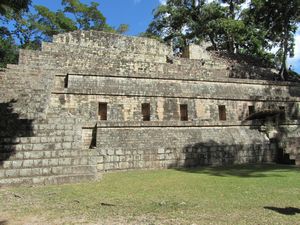Advertisement
Published: January 13th 2011

 Copan Ruinas
Copan Ruinas
One of the larger Mayan temples.We met our travel companions in Antigua over a meal with lots of drinks, which seemed to set the pattern for the next few days. This didn't affect our 4.00 a.m. departure the following morning for Copan, just over the border in Honduras. We've quickly learned that any journey involving a Central American border crossing will take longer than you think. Sometimes much longer. Still, it's fun to see the money-changers surging up holding improbably huge wads of notes, and deciding who looks the least villainous. Copan (actually called Copan Ruinas) is a pretty little town, totally dependent on tourism to the Mayan site of the same name about 2 km away. Copan is much smaller than Tikal (see earlier blog) but compact and easily accessed, with some excellent carvings. The museum on the site is a must: most of the best stellae have been removed there and are very well-displayed. From what we have seen, Honduras looks more prosperous than Guatemala and the people are just as friendly. The 7.00 a.m. departure the following day gave no warning of the hard slog to get to Roatan, one of the Bay Islands on the Caribbean coast. Ten hours on the road
was followed by a 90-minute ferry ride and then a half-hour drive to our hotel. Morale improved after the - by now - standard chicken, rice and beans and the odd beer or two. Roatan is beautiful. Classic soft sandy beaches, palm trees, Caribbean-pace and clear pale blue sea inside a 90km coral reef. We could have stayed for longer, but three days were enough to adapt to living in shorts and flip-flops. Oddly enough, the locals all speak English - a legacy of many pirates, buccaneers, the Royal Navy and over 100 years of British colonial rule (we gave the Bay Islands back to Honduras in 1859). You can snorkel straight off the beach - the reef starts only yards off, and the fish (the whole area is a marine park) are totally unfazed by people. Mary found Nemo! And apart from clown fish there were angel fish, barracuda, and lots of nameless (to us) impossibly brightly coloured fish. If you stayed still long enough, they would swim up in front of your mask and peer in. Sadly, all good things come to an end and our departure was at 4.45. We got to the airport at 5.05, which
was nice in its own way, but perhaps a little unnecessary as the gates were locked and no one turned up until the airport opened at 6.00. Our leader faced down the mutiny, and the flight to La Ceiba and the next one on to Tegucigalpa made up for the early start. However, then it was into a bus again for 8 hours (including crossing the border into Nicaragua) to get to Leon. Nicaragua is the poorest country in C America, with a dreadful history of wars - civil and otherwise - finally ending in 1988. They are trying hard to get over their history, but reminders of the Sandinistas, the Contras and the unlovely, corrupt, cruel regimes linger on. Leon, however, is an attractive ex-colonial town with a cathedral and 17 churches. Tomorrow is Granada (and Mary's turn to write). Hasta pronto!
Advertisement
Tot: 0.081s; Tpl: 0.013s; cc: 7; qc: 44; dbt: 0.0447s; 1; m:domysql w:travelblog (10.17.0.13); sld: 1;
; mem: 1.1mb

 Copan Ruinas
Copan Ruinas
Dianne Bret Harte
non-member comment
Your dazzling photographic documentation proves my Honduran daughter-in-law's contention that her country's beauty can be breathtaking.